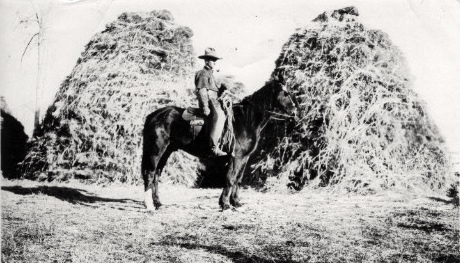Antique Tractors in the History of Making Hay
/The tractors that we now call “antique” served their owners well in many ways. One of the most important ways was their use in hay harvesting, when they pulled or powered equipment for mowing, raking, and baling. These days, haying is done with modern, enclosed, and air-conditioned tractors, but some people still keep those old machines in use, either out of necessity or as a link to our agricultural past. Some of that past was grueling. The story of haying is one that begins with a long period of hard physical labor that most of us cannot even imagine now.
Oliver Willsie proudly posed with his fine horse. He harvested hay in Alberta, Canada, sometime between 1910 and 1920. From the collection of Candace Brown
Thyra, Australia, Antique Hay Baling Festival
During the 1600s, before the cultivation of feed crops, livestock simply grazed in pastures. Without a store of food to sustain them over the winter, they faced starvation. By the mid-1700s, farmers began to grow clover, timothy, perennial ryegrass, and other grasses for feed. Alfalfa came later. Raking and mowing machines drawn by horses or oxen appeared in the early 1800s. Harvest capability increased tenfold. However, the hard work of hand cutting with a scythe and raking with wooden rakes continued until about 1840, or longer for those without access to the newest agricultural technology.
Amish Threshing Oats and Baling Straw
Baling was still a long way off in the future. Attempts to mechanize reaping and binding of hay into bundles involved many inventors, including Cyrus McCormick and his father Robert McCormick. Although Cyrus McCormick is usually credited as having invented the first successful mechanical reaper, the field had a lot of competition. By 1850, John Heath of Ohio, patented a reaper that would bind bundles with twine, but that method proved problematic at the time.
Other inventors, including Charles Withington, experimented with using wire. His 1872 invention of a reaper/binder that could knot the wire was admired by the McCormicks, who began to manufacture and sell it in 1874. With harvesting methods vastly improved, hay and beef production dramatically increased.
Northern Colorado Hay Harvest From 1930s to 2005
About this time, steam tractors also came into use, followed by those with internal combustion engines fueled by kerosene, gasoline, or distillate. The move from horsepower to tractor power represented a huge leap forward in farming technology.
By 1925 or so, the days of using horses were beginning to come to an end, but haystacks would prevail as a storage method for a while longer. Small stacks needed more protection from weather than larger ones, which acted like thatched roofs in the way that their shape encouraged water to run off the outer surface.
When baling machines were invented and put into use around the 1930s, those faithful farm tractors, which collectors now treasure and love, began powering the baling mahcines, producing square bales. By 1936, balers could automatically bind with twine.
Historic Hay Baling
Although the idea of round bales goes back to about 1910, it was not until Allis-Chalmers introduced the “Roto-Baler” in 1960 that round bales would become practical. The use of hydraulics made it possible to lift and move the bales. Now some of the round bales that we see dotting rural landscapes are also automatically wrapped.
This summer, I spent time with my relatives in Alberta, Canada. I thought about their long history of haying since their move to the area from Ontario over a century ago. Even in my lifetime, I’ve watched their farming methods and tractors change. As long as humans raise livestock, haying technology will no doubt keep improving, and so will the tractors. But some nostalgia for the old-fashioned ways and machines will remain, tempered by memories of heat, noise, and dust. If you can’t find those old tractors in the field, you certainly can find them in the pages of Antique Power magazine.
Making Round Hay Bales
From the collection of Candace Brown
If you can't find Antique Power on a newsstand near you, call 800-767-5828 or visit our Gift Shop to order current or back issues. To subscribe, call 888-760-8108 or click here.












